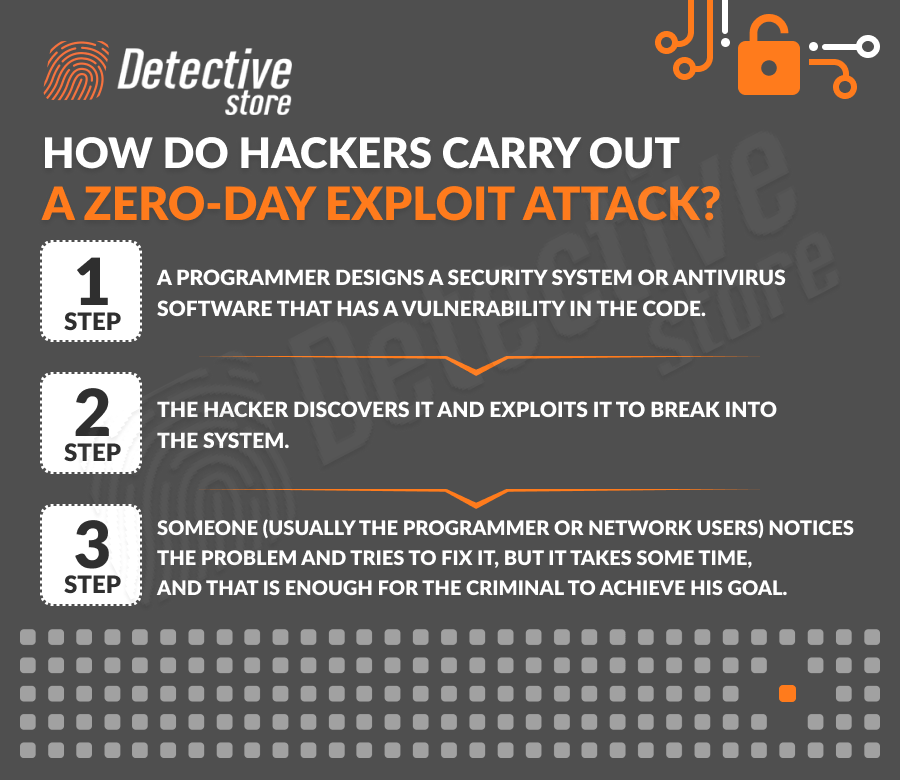In 2021, cybersecurity experts at Madiant reported 80 attacks targeting zero-day vulnerabilities in software and security systems – a record high, more than twice as many as the year before. Projections show that the upward trend is not only continuing, but will get stronger. And while avoiding the threat altogether is impossible, there are steps that can reduce the risk of a hacker attack. Learn what a zero-day exploit is and how you can protect yourself from it.
Zero-day vulnerability - a threat to company security

Developers are constantly on the lookout for bugs in the system that may have occurred during its development or update. If they find one, they immediately develop a “patch.” Most often, they make it available in the form of an installable update that includes security fixes and enhancements. Before that happens, however, every software weakness they don’t know about is a zero-day vulnerability. From the hackers’ point of view, they are most attractive for:
- operating systems,
- office programs and applications,
- virtual databases,
- Web browsers and e-mail,
- Open source components and licenses,
- IoT (Internet of Things) technologies.
Zero-day exploit - attack targeting a weak point

The zero-day exploit is one of the most dangerous digital attacks. It cannot be fully prevented. Consequently, it most often ends in a hacker’s success because, as the name says, the developer has 0 days to fix the bugs. While he or she is trying to patch the hole, the cybercriminal exploits zero-day vulnerabilities to install malicious software (malware) on the device, stealing money, confidential business data or intellectual property. In the worst cases, such code omissions go undetected for years and the hacker repeatedly abuses the same source.
Interestingly, often the person who discovers the zero-day exploit is not the one who attacks a company’s security system. Some cybercriminals look for holes in software only to sell the information about them on the black market. In addition to them, the zero-day exploit method is also used by:
- hacktivists, or hackers who act in the public interest (such as Anonymous),
- corporate spies,
- political actors who attack another country’s IT infrastructure.
How do hackers carry out a zero-day exploit attack?

Zero-day attacks are divided into targeted against potentially valuable targets (organizations, government agencies) and untargeted, i.e. carried out against users of specific systems or browsers. Each is different, but they are all based on a similar pattern.
- A programmer designs a security system or antivirus software that has a vulnerability in the code.
- A hacker discovers it and exploits it to break into the system.
- Someone (usually the programmer or network users) notices the problem and tries to fix it, but it takes time, and that’s enough for the criminal to achieve his goal.
One of the most famous zero-day attacks targeted Sony Pictures Entertainment in 2014. Hackers exploited a vulnerability in computer systems to release the company’s business plans and executives’ private email addresses, among other things.
Zero-day vulnerability detection and attack prevention

There is no one-size-fits-all way to protect against zero-day attacks, but you can try to reduce the risk of cyber threats and minimize their effects.
Windows Defender Exploit Guard
Windows Defender Exploit Guard is an EMET tool. This means that it reduces the risk of vulnerabilities in your system and the applications you use: it encrypts important files, detects malware, and interrupts suspicious network connections.
Patch management system and system updates
Patch management should be a priority for your IT department. Consistently conducted, it includes activities such as regularly searching for updates, planning to deploy them and testing the changes they make.
(Cyber)education of company employees
Many hacking attacks are carried out successfully, thanks to mistakes made by people. Preventive measures should also include training employees on Internet security. They should be regularly made aware of how to choose strong passwords and protect personal information.
Zero-day vulnerabilities - FAQ
Learn the answers to the most frequently asked questions!
What does zero-day mean in the field of cyber security?
A zero-day vulnerability is a flaw in software or system security that the author is unaware of. Its name refers to how much time a programmer has to fix the flaw from the moment he or she learns about it.
How are zero-day attacks detected?
Zero-day attacks are revealed, among other things, by antivirus programs that record suspicious activity. However, if they are successfully carried out – they can remain undetected for up to several years.











Leave a Reply